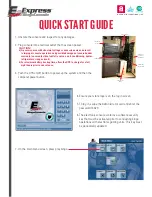
61
60
APERTURE RANGE GRAPH (TWIN FLASH)
The aperture range for macro lenses is displayed on page 30 (TTL),
and page 38 (Manual flash). The aperture ranges described here are
for lenses other than macro lenses, or when the subject distance is
great.
TTL flash metering
Min. Aperture lines
Max. Aperture lines
A
B
C
Flash-subject distance
1.Draw a vertical line from the flash-subject distance until it reaches
the flash power line which corresponds to power level set (A).
2.Draw a horizontal line from the intersection of step 1 until it
reaches a vertical film speed line corresponding to the film used
(B).
3.Draw a diagonal line from the intersection of step 2. The result
indicates the aperture needed (C).
• The figures in parenthesis are employed when only one twin flash
unit is used.
Example: at 1.5m flash-subject distance, with a power level of 1/1,
and ISO 100 film, the aperture required for a proper exposure is
f/16.
Manual flash metering
Flash Power lines
A
B
C
Flash-subject distance
1/1
1/2 (1/1)
1/4 (1/2)
1/8 (1/4)
1/16 (1/8)
1/32 (1/16)
1/64 (1/32)
(1/64)
1.Draw a vertical line from the flash-subject distance until it reaches the
min. aperture line (A).
2.Draw a horizontal line from the intersection of step 1 until it reaches a
vertical film speed line corresponding to the film used (B).
3.Draw a diagonal line from the intersection of step 2. The result indi-
cates the minimum aperture that can be used (C).
• The maximum aperture can be obtained in the same way by using the
max. aperture line. The results of both calculations will give the usable
aperture range (D).
• The dotted lines are employed when only one twin flash unit is used.
Example: at 1.5m flash to subject distance and with ISO 100 film, the
usable aperture range will be larger than f/16. The limit to the usable
aperture range will be the aperture range of the lens.
D







































